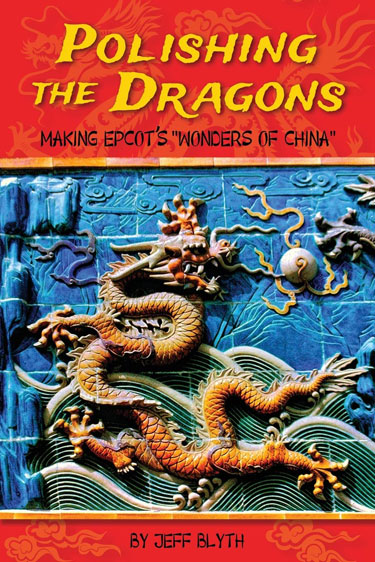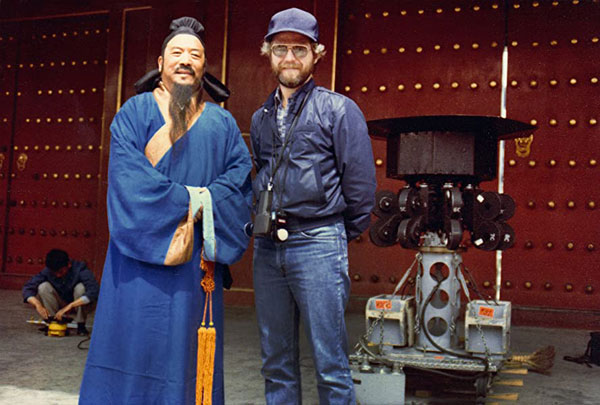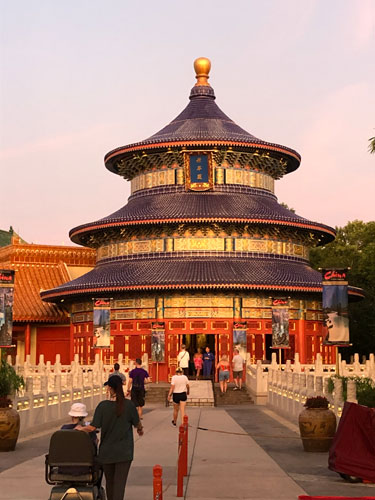
The best theme park attractions feel like magic. We don’t question how they came into being; they just exist. A film like Rick Harper’s Impressions de France glides through the French countryside like it’s free of rules. This feeling is everywhere in the best Circle-Vision 360 attractions. We rarely ponder how difficult it was to create the immersive footage. Filmmaker Jeff Blyth has accomplished this feat many times. His book Polishing the Dragons explores the challenges to present China to Disney guests.
Blyth’s Circle-Vision film Wonders of China was an opening-day attraction at EPCOT Center on October 1st, 1982. Located inside a gorgeous replica of the Temple of Heaven from Beijing, the movie offered guests a rare look at China during that time period. The country was very different from the growing economic giant we know today. Despite bureaucratic and logistical obstacles during the shoot, Blyth and his crew ultimately created a beautiful film.
Our guide in Wonders of China is the eighth-century poet Li Bai, played by Shih Kuan and voiced by Keye Luke. It’s a clever way to introduce audiences unfamiliar with China to various locales. In particular, the chance to visit The Forbidden City was a major achievement. Blyth showcases both wide-open landscapes and intimate spaces in the 19-minute Circle-Vision film. But there’s much more to the story. Polishing the Dragons describes every step in the journey for Blyth to direct the classic attraction.
A Personal Narrative
What makes this book so interesting is the way Blyth presents the story. This isn’t your typical Disney history book; it’s written like we’re right alongside the author. When Blyth describes staying in rough hotel rooms with unseen creatures scurrying around his bed, it’s easy to connect with that experience. We’ve all worked with skilled but challenging figures like his production manager Leon Chooluck. Blyth presents a detailed background of every part of the production, not just shooting the scenes.
In the foreword, Blyth describes the book as “an up close and very personal view of a People’s Republic of China (PRC) that no longer exists“. I’m too young to remember what China was like in the early ’80s and appreciated getting that perspective in this book. So much has changed in the past 40 years. Filming in China was a rare privilege for Disney. Blyth explains their role essentially as ambassadors during banquets and other events. This wasn’t the typical job.
Polishing the Dragons should interest more than diehard theme park fans because of Blyth’s great storytelling. A perfect example is his chapter on the “Train Ride from Hell” after a journey to shoot the Xinjiang Province. Rough weather essentially stranded the crew and led to a torturous train ride back to Beijing. This example reminds us that filmmaking isn’t such a glamorous job, even at Disney. I now appreciate the creative success of Wonders of China so much more after reading this book.

Inventive Techniques
Despite the challenges, it’s hardly a downbeat story from Blyth. He describes every aspect of the journey, including the positive moments. What stands out to me is how much ingenuity it took to shoot Wonders of China. The Circle-Vision format doesn’t make shooting easy, particularly in another country. For example, the steam engine scene needed exact timing and lighting to capture the train exiting the tunnel. That doesn’t even consider dealing with smoke from the engine filling the space!
Blyth also explains the considerable location scouting needed beyond the filming time. This prep time pays off when we see the final product. Everything fits together well in Wonders of China, and Blyth gives us all the background. He also tried to learn Mandarin to lessen the language barrier. Translators were crucial to the production, but it still wouldn’t hurt. It’s another reminder of the differences with this shoot.
The book’s title relates to shooting at the Nine-Dragon Wall at the Forbidden City. The fun anecdote of the crew grabbing a bucket of water and rags again reinforces how rare this film was at the time. The layer of dust and dirt had likely been on the dragons for two hundred years. It’s another instance where Blyth and his crew improvised to get the right shots. There are countless examples like this one contained in this book.
A Wondrous Experience
One of the best aspects of Polishing the Dragons is the collection of color photos at the start of every chapter. These shots do more than just support Blyth’s stories. They also showcase how much dedication it took to create Wonders of China. Blyth would return to a very different China to film the update Reflections of China in 2002. The original production captured a country poised for change and rarely seen outside its borders.
Whether you’re a fan of early EPCOT Center, the Circle-Vision technology, or just a great story, there’s plenty to appreciate in this book. Blyth takes us well beyond what we might expect to learn about a theme park film. A perfect companion to this book is this complete look at the China pavilion from Martin’s Videos. Blyth also posted a cool behind-the-scenes video on Reflections of China on his channel.
These examples support the accomplishments described in Polishing the Dragons. It’s refreshing to learn the unvarnished truth about what it took to create this film. Blyth’s candid descriptions remind us what’s needed to build the magic. Let’s make sure we don’t take the films for granted, even after they no longer play in the parks.

Related Book Reviews: Polishing the Dragons
The Thinking Fan’s Guide to Walt Disney World: EPCOT by Aaron Wallace
From Horizons to Space Mountain by George McGinnis
Great Big Beautiful Tomorrow by Christian Moran
This post contains affiliate links. Making any purchase through those links supports this site. See full disclosure.



Leave a Reply